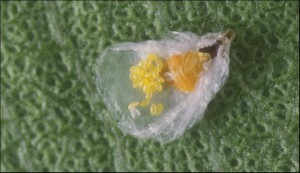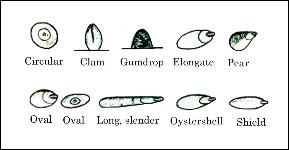Armored and soft scales are very common in Florida Keys landscapes. These insects damage many ornamental plants by sucking out the fluids. Indications of possible scale infestation include the presence of sooty mold (review Florida Keys Landscape Advisor article “What is that Black Stuff on my plant leaves?”) or ants, lack of new growth, stippling (small yellow spots) or chlorotic lesions, extensive leaf yellowing, and premature leaf drop.
Armored scales live and feed under a waxy covering that is not attached to the body. They range in size from 1/16 to 1/8 inch in diameter and come in many shapes and colors. They do not secrete honeydew.
Soft scales have an attached waxy coating and also come in a variety of colors, shapes (flat to spherical), and sizes (1/8 to 1/2 inch). They excrete a lot of honeydew, which attracts ants and is the medium for the growth of sooty mold.
 Scale eggs usually hatch within three weeks after they are laid. Crawlers move around on their own or can be spread by the wind. Once they have found a new host plant, they begin to feed by sticking their needle-like mouthpart into the leaf surface.
Scale eggs usually hatch within three weeks after they are laid. Crawlers move around on their own or can be spread by the wind. Once they have found a new host plant, they begin to feed by sticking their needle-like mouthpart into the leaf surface.Severe scale problems can be prevented by early detection and good cultural practices. Learn what scales look like and inspect plants often with a magnifying glass. Small infestations can be pruned off and destroyed. Provide good air flow and do not overfertilize.
Scale populations are controlled naturally by predators such as ladybird beetles and lacewings as well as parasitic wasps. If beneficial insects are present, consider letting them them do their jobs before you apply use a pesticide. For detailed information about biological and chemical controls see http://edistt.ifas.ufl.edu/mg005
See the following sources for information about specific scale pests:
Cycad Aulacaspis Scale, Aulacaspis yasumatsui Takagi (EENY-096) (http://edis.ifas.ufl.edu/IN253)
Cottony Cushion Scale, Icerya purchasi Maskell (http://edis.ifas.ufl.edu/IN161)
False Oleander Scale, Pseudaulacaspis cockerelli (Cooley) (EENY-149) (http://edis.ifas.ufl.edu/IN306)
Green Scale, Coccus viridis (Green) (EENY-253) (http://edis.ifas.ufl.edu/IN436)
Lesser Snow Scale: http://edistt.ifas.ufl.edu/ig070
Lobate Lac Scale, Paratachardina lobata lobata (Chamberlin) (EENY-276) (http://edis.ifas.ufl.edu/IN471), http://entomology.ifas.ufl.edu/creatures/orn/scales/lobate_lac.htm
Red Wax Scale, Ceroplastes rubens Maskell (EENY-237) (http://edis.ifas.ufl.edu/IN393)
Scale Pests of Florida Citrus (ENY-814) (http://edis.ifas.ufl.edu/CH059)
White Peach Scale, Pseudaulacaspis pentagona (Targioni) (EENY-076) (http://edis.ifas.ufl.edu/IN233)
New soft scale on Croton
http://www.freshfromflorida.com/pi/pest-alerts/coccoidea-coccidae.html
To see photographs of some common Florida scales, see:
http://edistt.ifas.ufl.edu/mg005
These links were updated in March, 2013.
Article compiled by Master Gardener Ellen Sculley from multiple University of Florida scale fact sheets.
Photo Credits:
UF/IFAS
 0
0

